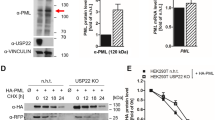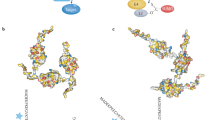Abstract
In acute promyelocytic leukaemia (APL), the promyelocytic leukaemia (PML) protein is fused to the retinoic acid receptor α (RAR). This disease can be treated effectively with arsenic, which induces PML modification by small ubiquitin-like modifiers (SUMO) and proteasomal degradation. Here we demonstrate that the RING-domain-containing ubiquitin E3 ligase, RNF4 (also known as SNURF), targets poly-SUMO-modified proteins for degradation mediated by ubiquitin. RNF4 depletion or proteasome inhibition led to accumulation of mixed, polyubiquitinated, poly-SUMO chains. PML protein accumulated in RNF4-depleted cells and was ubiquitinated by RNF4 in a SUMO-dependent fashion in vitro. In the absence of RNF4, arsenic failed to induce degradation of PML and SUMO-modified PML accumulated in the nucleus. These results demonstrate that poly-SUMO chains can act as discrete signals from mono-SUMOylation, in this case targeting a poly-SUMOylated substrate for ubiquitin-mediated proteolysis.
This is a preview of subscription content, access via your institution
Access options
Subscribe to this journal
Receive 12 print issues and online access
$209.00 per year
only $17.42 per issue
Buy this article
- Purchase on Springer Link
- Instant access to full article PDF
Prices may be subject to local taxes which are calculated during checkout







Similar content being viewed by others
Accession codes
References
Hay, R. T. SUMO: a history of modification. Mol. Cell 18, 1–12 (2005).
Rodriguez, M. S., Dargemont, C. & Hay, R. T. SUMO-1 conjugation in vivo requires both a consensus modification motif and nuclear targeting. J. Biol. Chem. 276, 12654–12659 (2001).
Tatham, M. H. et al. Polymeric chains of sumo-2 and sumo-3 are conjugated to protein substrates by sae1/sae2 and ubc9. J. Biol. Chem. 276, 35368–35374 (2001).
Matic, I. et al. In vivo identification of human SUMO polymerization sites by high accuracy mass spectrometry and an in vitro to in vivo strategy. Mol. Cell Proteomics 1,132–144 (2007).
Hecker, C. M., Rabiller, M., Haglund, K., Bayer, P. & Dikic, I. Specification of SUMO1 and SUMO2 interacting motifs. J. Biol. Chem. 23, 16117–16127 (2006).
Song, J., Durrin, L. K., Wilkinson, T. A., Krontiris, T. G . & Chen, Y. Identification of a SUMO-binding motif that recognizes SUMO-modified proteins. Proc. Natl Acad. Sci. USA 101, 14373–14378 (2004).
Prudden, J. et al. SUMO-targeted ubiquitin ligases in genome stability. EMBO J. 26, 4089–101 (2007).
Sun, H., Leverson, J. D. & Hunter, T. Conserved function of RNF4 family proteins in eukaryotes: targeting a ubiquitin ligase to SUMOylated proteins. EMBO J. 26, 4102–4112 (2007).
Uzunova, K. et al. Ubiquitin-dependent proteolytic control of SUMO conjugates. J. Biol. Chem. 47, 34167–34175 (2007).
Xie, Y. et al. The yeast HEX3–SLX8 heterodimer is a ubiquitin ligase stimulated by substrate sumoylation. J. Biol. Chem. 47, 34176–34184 (2007).
Moilanen, A. M. et al. Identification of a novel RING finger protein as a co-regulator in steroid receptor-mediated gene transcription. Mol. Cell Biol. 18, 5128–5139 (1998).
Hakli, M., Lorick, K. L., Weissman, A. M., Janne, O. A. & Palvimo, J. J. Transcriptional co-regulator SNURF (RNF4) possesses ubiquitin E3 ligase activity. FEBS Lett. 560, 56–62 (2004).
Ong, S. E., Kratchmarova, I. & Mann, M. Properties of 13C-substituted arginine in stable isotope labeling by amino acids in cell culture (SILAC). J. Proteome Res. 2, 173–181 (2003).
Chen, G. Q. et al. In vitro studies on cellular and molecular mechanisms of arsenic trioxide (As2O3) in the treatment of acute promyelocytic leukemia: As2O3 induces NB4 cell apoptosis with downregulation of Bcl-2 expression and modulation of PML–RAR α/PML proteins. Blood 88, 1052–1061 (1996).
Lallemand-Breitenbach, V. et al. Role of promyelocytic leukemia (PML) sumolation in nuclear body formation, 11S proteasome recruitment, and As2O3-induced PML or PML/retinoic acid receptor alpha degradation. J. Exp. Med. 193, 1361–1371 (2001).
Muller, S., Miller, W. H., Jr & Dejean, A. Trivalent antimonials induce degradation of the PML–RAR oncoprotein and reorganization of the promyelocytic leukemia nuclear bodies in acute promyelocytic leukemia NB4 cells. Blood 92, 4308–4316 (1998).
Shao, W. et al. Arsenic trioxide as an inducer of apoptosis and loss of PML/RAR α protein in acute promyelocytic leukemia cells. J. Natl Cancer Inst. 90, 124–133 (1998).
Sternsdorf, T. et al. PIC-1/SUMO-1-modified PML–retinoic acid receptor α mediates arsenic trioxide-induced apoptosis in acute promyelocytic leukemia. Mol. Cell Biol. 19, 5170–5178 (1999).
Zhu, J. et al. Arsenic-induced PML targeting onto nuclear bodies: implications for the treatment of acute promyelocytic leukemia. Proc. Natl Acad. Sci. USA 94, 3978–3983 (1997).
Duprez, E. et al. SUMO-1 modification of the acute promyelocytic leukaemia protein PML: implications for nuclear localisation. J. Cell Sci. 112, 381–393 (1999).
Kamitani, T. et al. Identification of three major sentrinization sites in PML. J. Biol. Chem. 273, 26675–26682 (1998).
Burgess, R. C., Rahman, S., Lisby, M., Rothstein, R. & Zhao, X. The slx5–slx8 complex affects sumoylation of DNA repair proteins and negatively regulates recombination. Mol. Cell Biol. 27, 6153–6162 (2007).
Kosoy, A., Calonge, T. M., Outwin, E. A. & O'Connell, M. J. Fission yeast Rnf4 homologs are required for DNA repair. J. Biol. Chem. 282, 20388–20394 (2007).
Wang, Z., Jones, G. M. & Prelich, G. Genetic analysis connects SLX5 and SLX8 to the SUMO pathway in Saccharomyces cerevisiae. Genetics 172, 1499–1509 (2006).
Hakli, M., Karvonen, U., Janne, O. A. & Palvimo, J. J. SUMO-1 promotes association of SNURF (RNF4) with PML nuclear bodies. Exp. Cell Res. 304, 224–233 (2005).
Brons-Poulsen, J., Petersen, N. E., Horder, M. & Kristiansen, K. An improved PCR-based method for site directed mutagenesis using megaprimers. Mol. Cell Probes 12, 345–348 (1998).
Shen, L. et al. SUMO protease SENP1 induces isomerization of the scissile peptide bond. Nature Struct. Mol. Biol. 13, 1069–1077 (2006).
Desterro, J. M., Thomson, J. & Hay, R. T. Ubch9 conjugates SUMO but not ubiquitin. FEBS Lett. 417, 297–300 (1997).
Shen, L. N., Dong, C., Liu, H., Naismith, J. H. & Hay, R. T. The structure of SENP1–SUMO-2 complex suggests a structural basis for discrimination between SUMO paralogues during processing. Biochem. J. 397, 279–288 (2006).
Acknowledgements
This work was supported by Cancer Research UK and the RUBICON EU Network of Excellence. A. P was supported by a Wellcome Trust Studentship. We would like to thank Hugues de The for helpful discussions and providing the chicken anti-PML antibody, and Douglas Lamont, manager of the Fingerprints Proteomics Facility, University of Dundee, for generating the Orbitrap mass spectrometry data. The provision of critical reagents by Roel van Driel and Dan Bailey is gratefully acknowledged.
Author information
Authors and Affiliations
Contributions
M. H. T. carried out the biochemical and proteomic analyses and participated in the writing of the manuscript; M. C. G. carried out the in vivo analysis of PML degradation; L. S. generated and assayed expressed proteins and mutants of RNF4; A. P. carried out ubiquitin site-mapping on poly-SUMO chains modified in vitro; N. H. was involved in initial immunofluorescence microscopy studies; E. J. G. established conditions for siRNA depletion of RNF4; J. J. P. generated expression constructs and antibodies to RNF4; R. T. H. conceived the project and wrote the manuscript. All authors discussed the results and commented on the manuscript.
Corresponding author
Ethics declarations
Competing interests
The authors declare no competing financial interests.
Supplementary information
Supplementary Information
Supplementary Figures S1, S2, S3, S4, S5 (PDF 1450 kb)
Rights and permissions
About this article
Cite this article
Tatham, M., Geoffroy, MC., Shen, L. et al. RNF4 is a poly-SUMO-specific E3 ubiquitin ligase required for arsenic-induced PML degradation. Nat Cell Biol 10, 538–546 (2008). https://doi.org/10.1038/ncb1716
Received:
Accepted:
Published:
Issue Date:
DOI: https://doi.org/10.1038/ncb1716
This article is cited by
-
Concerted SUMO-targeted ubiquitin ligase activities of TOPORS and RNF4 are essential for stress management and cell proliferation
Nature Structural & Molecular Biology (2024)
-
TRIM28-mediated nucleocapsid protein SUMOylation enhances SARS-CoV-2 virulence
Nature Communications (2024)
-
BioE3 identifies specific substrates of ubiquitin E3 ligases
Nature Communications (2023)
-
SPRTN patient variants cause global-genome DNA-protein crosslink repair defects
Nature Communications (2023)
-
Deubiquitinating enzymes and the proteasome regulate preferential sets of ubiquitin substrates
Nature Communications (2022)



